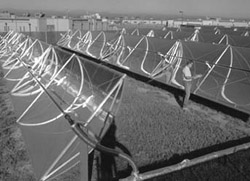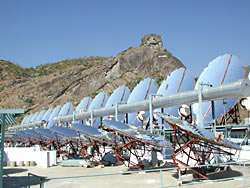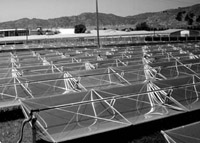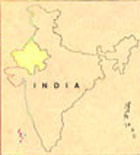By Gordon Feller
Rajastan, India

Parabolic Trough Array, Brighton, Colorado, USA photo: US D.O.E. |

|
Editor's Note: Just as on a small scale, hybrid engines stretch a gallon of gas, in the same manner a hybrid power plant can stretch its own supply of fossil fuel. In India, a huge new power station using hybrid systems is close to completing their financing and breaking ground in the sunny state of Rajasthan. This fossil fuel / solar hybrid will produce a whopping 140 megawatts of electric power, and 40 of those megawatts will be produced from a field of solar thermal parabolic troughs. Not as glamorous as photovoltaics, but still much more cost-effective, parabolic systems use mirrors to focus sunlight that in turn heats a thermal media (gas, steam) to drive a turbine generator. The project described below is projected to go in at about US $1 million per megawatt, which is competitive with conventional fuels. Read on...
India's power sector has a total installed capacity of approximately 102,000 MW of which 60% is coal-based, 25% hydro, and the balance gas and nuclear-based. Power shortages are estimated at about 11% of total energy and 15% of peak capacity requirements and are likely to increase in the coming years. In the next 10 years, another 10,000 MW of capacity is required. The bulk of capacity additions involve coal thermal stations supplemented by hydroelectric plant development. Coal-based power involve environmental concerns relating to emissions of suspended particulate matter (SPM), sulfur dioxide (SO2), nitrous oxide, carbon dioxide, methane and other gases. On the other hand, large hydroplants can lead to soil degradation and erosion, lo! ss of forests, wildlife habitat and species diversity and most importantly, the displacement of people. To promote environmentally sound energy investments as well as help mitigate the acute shortfall in power supply, the Government of India is promoting the accelerated development of the country's renewable energy resources and has made it a priority thrust area under India's National Environmental Action Plan (NEAP).
Throughout the 1990's, India's private sector interest in renewable energy increased due to several factors: (i) India opened the power sector to private sector participation in 1991; (ii) tax incentives are now offered to developers of renewable energy systems; (iii) there has been a heightened awareness of the environmental benefits of renewable energy relative to conventional forms and of the short-gestation period for developing alternate energy schemes. Recognizing the opportunities afforded by private sector participation, the Indian Government revised its priorities in July 1993 by giving greater emphasis on promoting renewable energy technologies for power generation. To date, over 1,500 MW of windfarm capacity has been commissioned and about 1,423 MW capacity of small hydr! o installed. The sector's contribution to energy supply has grown from 0.4% of India's power capacity in 1995 to 3.4% by 2001.
![]() India
is located in the equatorial sun belt of the earth, thereby receiving abundant
radiant energy from the sun. The India
Meteorological Department maintains a nationwide network of radiation
stations which measure solar radiation and also the daily duration of sunshine.
In most parts of India, clear sunny weather is experienced 250 to 300 days
a year. The annual global radiation varies from 1600 to 2200 kWh/sq.m.
which is comparable with radiation received in the tropical and sub-tropical
regions. The equivalent energy potential is about 6,000 million GWh of
energy per year. The highest annual global radiation is received in Rajasthan
and northern Gujarat. In ! Rajasthan, large areas of land are barren and
sparsely populated, making these areas suitable as locations for large
central power stations based on solar energy.
India
is located in the equatorial sun belt of the earth, thereby receiving abundant
radiant energy from the sun. The India
Meteorological Department maintains a nationwide network of radiation
stations which measure solar radiation and also the daily duration of sunshine.
In most parts of India, clear sunny weather is experienced 250 to 300 days
a year. The annual global radiation varies from 1600 to 2200 kWh/sq.m.
which is comparable with radiation received in the tropical and sub-tropical
regions. The equivalent energy potential is about 6,000 million GWh of
energy per year. The highest annual global radiation is received in Rajasthan
and northern Gujarat. In ! Rajasthan, large areas of land are barren and
sparsely populated, making these areas suitable as locations for large
central power stations based on solar energy.
The main objectives of the project are these: (i) To demonstrate the operational viability of parabolic trough solar thermal power generation in India; (ii) support solar power technology development to help lead to a reduction in production cost; and (iii) help reduce greenhouse gas (GHG) global emissions in the longer term. Specifically, operational viability will be demonstrated through operation of a solar thermal plant with commercial power sales and delivery arrangements with the grid. Technology development would be supported through technical assistance and training. The project would be pursued under The World Bank's Global Environment Fund (GEF) -- which has a leading program objective focused on climate change. This project is envisaged as the first step of a long term program for promoting solar thermal power in India that would lead to a phased deployment of similar systems in the country and possibly in other developing nations.
India supports development of both solar thermal and solar photovoltaics (PV) power generation. To demonstrate and commercialize solar thermal technology in India, MNES is promoting megawatt scale projects such as the proposed 35MW solar thermal plant in Rajasthan and is encouraging private sector projects by providing financial assistance from the Ministry.
One of the prime objectives of the demonstration project is to ensure capacity build-up through 'hands on' experience in the design, operation and management of such projects under actual field conditions. Involvement in the project of various players in the energy sector, such as local industries, the private construction and operations contractors, Rajasthan State Power Corporation Limited (RSPCL), Rajasthan State Electricity Board (RSEB), Rajasthan Energy Development Agency (REDA), Central Electricity Authority (CEA), MNES and others, will help to increase the capacity and capability of local technical expertise and further sustain the development of solar power in India in the longer term.
The project's sustainability will depend on to what extent the impact of the initial investment cost is mitigated, operating costs fully recovered, professional management introduced, and infrastructure and equipment support for operation and maintenance made accessible. Accordingly, while the solar thermal station will be state-owned, it will be operated during the initial five years under a management contract with the private sector; subsidy support will be limited to capital costs. Fuel input, power supply and other transactions would be on a commercial basis and backed up by acceptable marketable contracts. Staff selection and management would be based on business practices; the project site would be situated where basic infrastructure is well developed and engineering industries established.

Parabolic
Trough Array, Tehachapi, California, USA
photo:
US D.O.E.
This project is consistent with the World Bank's Global Environment Fund's operational strategy on climate change in support of long-term mitigation measures. In particular, the project will help reduce the costs of proven parabolic trough solar technology so as to enhance its commercial viability. This initiative is part of an anticipated multi-country solar thermal promotion program, the objectives of which will be to accelerate the process of cost reduction and demonstrate the technology in a wider range of climate and market conditions.
Demonstrating the solar plant's operational viability under Indian conditions is expected to result in follow-up investments by the private sector both in the manufacture of the solar field components and in larger solar stations within India.
Insights into local design and operating factors such as meteorological and grid conditions, and use of available back-up fuels, are expected to lead to its replicability under Indian conditions, opening up avenues for larger deployment of solar power plants in India and other countries with limited access to cheap competing fuels. Creation of demand for large scale production of solar facilities will in turn lead to reductions in costs of equipment supply and operation. It is also expected to revive and sustain the interest of the international business and scientific community in improving systems designs and operations of solar thermal plants.
The Project is expected to result in avoided annual emissions of 714,400 tons of CO2, or 17.9 million tons over the life of the project, relative to generation from a similar-sized coal-fired power station. The cost of carbon avoidance is estimated at $6.5 per ton.
The project involves: (i) Construction of a solar thermal/fossil-fuel hybrid power plant of about 140MW incorporating a parabolic trough solar thermal field of 35 MW to 40 MW; and (ii) Technical assistance package to support technology development and commercialization requirements.

The design choice is an Integrated Solar Combined Cycle (ISCC) involving the integrated operation of the parabolic trough solar plant with a combined cycle gas turbine using naphtha. Such a plant would consist of the solar field; a combined cycle power block involving two gas turbines each connected to a heat recovery steam generator (HRSG) and a steam turbine connected to both HRSG; and ancillary facilities and plant services such as fire protection, regasified liquefied natural gas supply and storage system, grid interconnection system, water supply and treatment systems, etc. A control building will house a central microprocessor control system that monitors and controls plant operations.
The success of the solar thermal/hybrid power plant as a demonstration project will determine if this technology is replicable in other parts of India. The project will provide technical assistance to ensure that adequate institutional and logistical support for the technology is available for future expansion of solar thermal power.
Specifically, funds will be made available for promoting commercialization of solar thermal technologies among potential investors; staff training and development of a local consultancy base; upgrading of test facilities; mproved collection and measurement of solar insolation data and other solar resource mapping activities; and development of pipeline investments.
The total cost of the investment component is estimated at US$ 201.5 million, including interest during construction, physical and price contingencies as well as duties and taxes. Of these costs, the cost of supplies (excluding contingencies) for the solar component including the steam generator amounts to $41 million, and that for the conventional power plant component is $72 million. The cost of the technical assistance component for promoting replication of the solar power technology is estimated at $4 million.

Investors Note: For more information on the solar thermal project in Rajasthan, India, please contact:
Mr.
G. L. Somani, General Manager
Rajasthan
State Power Corporation Ltd.
E-166,
Yudhisthar Marg, C-Scheme, Jaipur, India
Telephone
No.: (91-141) 384055
Fax
No.: (91-141) 382759